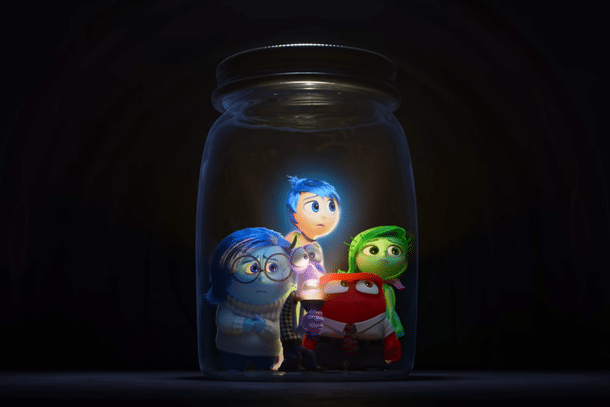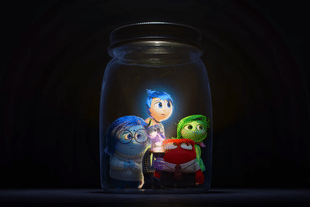Culture
The 'Inside Out' Films Are Doing What Indian Films Aren't — Providing A Window Into The Language Of The Puranas
Aravindan Neelakandan
Jul 17, 2024, 10:07 AM | Updated Aug 29, 2024, 01:02 PM IST
Save & read from anywhere!
Bookmark stories for easy access on any device or the Swarajya app.


Pixar Animation Studios is an important cultural force in the West. On our globalised and digitally well-connected planet, its impact cuts across East-West civilisational boundaries.
Many Pixar movies, with a young audience as its primary target, boldly venture into the deep questions of life, existence, and the mysteries of the inner kind.
Inside Out (2015), Coco (2017), Soul (2020), and now Inside Out 2 (2024) all journey into the inner lives of their protagonists, while some also look at what happens in near-death-experience-like states.
Clearly, these movies, while anchored in Western Christian culture, and even mostly what could be considered traditional Western family and social values in a positive sense, importantly explore the deep inner processes of individuals.
The result is that these movies, as a genre, make the worldview of the audience gravitate towards what could be considered the ‘Eastern’ or Hindu-Buddhist worldview. This is more than a New-Age fascination.
Inside Out became a cult classic when it came out. It explored the inner life of a pre-teen girl when the family moves from Minnesota to San Francisco because the father gets a new job.
The girl's behaviour is shown as affected by the five basic emotions — joy, sadness, anger, disgust, and fear. Joy is almost the inner world’s captain, and finally, joy learns the importance of sadness, whose activities joy had sought to minimise.
The conceptualisation of the formation of core memories, long-term memories, and the personality, or a sense of the individual self, flowering from all these inner processes makes the movie quite fascinating.
More important is the way the producers have conveyed to parents the core psychological concepts necessary for understanding a child, cutting across cultures.
A Hindu or Muslim parent can relate to the behaviour of the child and have an understanding of what they undergo, just as much as a Jewish or Christian parent. A child living in South India can empathise with the child on screen and figure out their own inner process.
This is the victory of the movie. True art contains in the heart of a localised story the feeling of the universal. Inside Out was true art.
Then, in 2024, came Inside Out 2, which deals with the emotional mayhem that a teenage girl undergoes within. The way the formation of the individual self is beset with possibilities. The struggle of the inner joy and other basic emotions to make sure the individual self emerges healthier and stronger without becoming a negative and powerful, selfish and not-so-honest self is depicted in such a marvellous way that it becomes a compelling viewing material. Every parent of a teenager can watch the movie twice, once with their teens and once alone.
More often than not, parents forget their inner struggles and remember only the final outward outcomes. Then, through that behavioural pattern, they judge their teen kids. This is a fallacy with potentially disastrous consequences.
The fundamental creative idea in both Inside Out movies is the way emotions are depicted as personalities of their own. Joy is a soft girl, anger is a harsh boy, and so on. (One wishes that the wokes do not get worked up about gender stereotyping.) But this characterisation of inner processes and emotions through anthropomorphic forms is very much a Hindu Puranic and spiritual technique, or rather in the spiritual tradition of Sanatana Dharma. It has been used for sadhana.
In the Hindu tradition, each Purana and even Itihasas become inner processes. This is for the supreme inner journey of the seeker.
In the famous Adhyatma Ramayana, Mother Sita tells Hanuman:
Know Rama to be the Supreme Brahman, the Existence-Knowldge-Bliss Absolute and the One without a second. He is pure Existence devoid of all adjuncts, whom the senses cannot perceive as their object... Know me to be the primeval Prakriti, the material and instrumental cause of the creation, sustenation and dissolution of the universe. In the mere presence of Rama, the Supreme Brahman, I, His Prakriti or Power, create the universe unwearied. What I create in His mere presence, the ignorant superimpose on Him.(Translation by Swami Tapasyananda)
One can easily see how the Ramayana, through these verses, transforms into the inner process of the sadhak without losing its Itihasic dimension.
It also connects cosmology and consciousness. That too not through any profound, complicated philosophical dimension, but in a lucid, devotional format.
The Ramayana, and for that matter, also the Puranas, happen in a liminal space-time-psyche node that is both inner-outer and eternal.
The power of the verses therein can free the Hindu mind from the traps of pseudo-scientific conceptions like creationism and intelligent design that plague the fundamentalist mind in dealing with the science of evolution.
Similarly, in the Skanda Purana, the three asuras Sura-Padmaasura, Simha-Mukhasura, and Tarakaasura become Ahankara, Karma, and Maya — the three inner binding forces forming an obstacle to liberation, with all the inner forces of goodness, the devas, imprisoned by these three.
The three asuras are born to Kasyapa, the Tapasvi, and Maya, the enchantress. While Skanda-Muruga destroys karmic bondage and the bondage of Illusion, the ego is not destroyed but subdued to become the vehicle of the divine.
It is not hard to see how the entire Skanda Purana can be meditated upon and, through devotional practices, invited inside the seeker. Or inversely, a seeker can find in Skanda Purana a veritable sacred cartography of the path to the pathless realm of consciousness.
Thirumular explicitly states that the destruction of Tripura by Siva is the destruction of the three inner pollutants. It happens, and happens in the sacred space-time of the seeker in her path.
But if an Indian director were to show the Tripura destruction by Siva, it would be more like an episode in that sub-moronic series Ancient Aliens than a depiction of the inner sacred processes.
Then, of course, there is Savitri by Sri Aurobindo. With 24,000 lines in blank verse, the epic poem provides extraordinary material to produce a Pixar-like graphic masterpiece showing both future evolution and inner sadhana. Perhaps we might have to wait for Pixar to do that.
It goes without saying that the Hindu Puranas and Itihasas are also literature for children. One of the vital functions of children's literature is to invoke in the child the deeper questions about the mystery of existence and their own inner processes.
Unlike in revealed religions, where reality is explained and is thus replete with answers, the Hindu religion, or rather the Hindu family of religions, aims to provide an experience of the inner kind, and makes the child, if interested, become a seeker of truth and have their own experience.
Today, it seems like Western movie corporates like Pixar have taken up the work of the Puranas for their children. Or corporates have become vehicles for the forces that want to take spirituality and a deeper concern for life and its mysteries to children.
They are definitely doing a wonderful job. The creative output is extraordinary. Equipped with three centuries of psychology as science and whatever remains of their pagan memories, they are in a way building from scratch and doing it magnificently.
Meanwhile, what are we doing?
The Indian creative intelligentsia and the film industry, despite the great wealth of our Darshanas and Puranas, are aping foreign special effects in lifeless drama versions of the Puranas instead of exploring ways to creatively explore the Puranic motifs deeply for today’s challenges and changed mindscapes.
Why are the Inside Out movies important for Indian parents?
They help you understand your children, and your children understand themselves in the web of life. The kids move from the individual-centred atomistic narrative of the West to a more connected inner-centric narrative.
With the Indian middle class pulled almost irresistibly to the Western-style consumerist culture, these movies help families touch base with a better and deeper understanding of themselves.
Further, these movies provide a wonderful opening for children to understand the Puranic language. These are movies, not Purana. A Purana is a sacred inner process landscape guide. These movies serve as an introduction to that guide.
When a youngster asks you how one should take the language of the Puranas, you have an answer: Inside Out provides an aesthetically pleasing introduction to the language of the Puranas.
As the entire Indian film industry has shown impotence in the use of Puranic wealth for building up individuals, families, and the nation and taking forwards the quest of the Upanishads, let us at least use what movies like Inside Out give us.





